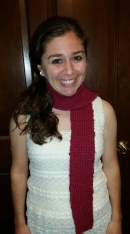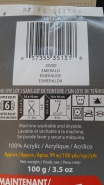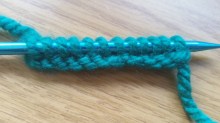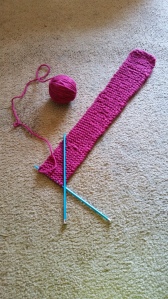
A couple of weeks ago I was given the challenge to pick something I wanted to learn how to do and attempt to do it. The catch was that I was only allowed to use online networks to learn this new skill. I could use resources such as blogs and Youtube videos, however, I could not get help from anyone in person. I wrote an initial post to explain this project as well as resources I thought might be helpful to learn how to knit a scarf. About a week later, I wrote a second post documenting my learning and my progress on my scarf. I knew that there would be a lot of resources available on the Internet, but I wasn’t really aware of how critical I would need to be in choosing the videos I used. I quickly realized that some videos were too fast and difficult to follow, while others were a much slower speed. This taught me a lot about what makes a good informational/ “how-to” video. You need to have good camera angles, speak slower than you think, and be very articulate and concise with what you say. After viewing a few videos multiple times, and countless hours of knitting, I finally finished my scarf! It was a very exciting moment when I was able to wrap it around my neck and say, “I made this all by myself” (or without the help of a physical human being showing me exactly what to do). In this blog post I will outline the different steps of learning how to knit my scarf as well as show a video that helps to demonstrate the steps of knitting a scarf. I decided to try to knit a second scarf to help create my video and refine my newly learned skill.
1. Picking the Right Yarn
Before going to the store I had to learn how to read a label of yarn. This label told me  what the yarn was made of, how to clean it, the appropriate size needles to use it with, and much more. This was slightly overwhelming at first, especially when I walked into the store, but I managed to find a yarn that I liked. When I went to get the yarn for my second scarf, I felt a little more confident in picking out the yarn because I had a better understanding of what it was like to work with the yarn.
what the yarn was made of, how to clean it, the appropriate size needles to use it with, and much more. This was slightly overwhelming at first, especially when I walked into the store, but I managed to find a yarn that I liked. When I went to get the yarn for my second scarf, I felt a little more confident in picking out the yarn because I had a better understanding of what it was like to work with the yarn.
2. Casting On
It was hard for me to follow this step at the beginning since the video I initially chose went too quickly for me. However, after a little more digging I found a woman named Judy, who has her our knitting tips channel, and seemed to easily explain this process to me. I was able to create my initial stitches and move on.
3. Knit Stitch
Once you have cast on your initial stitches, you then begin to add additional stitches. Judy once again helped me to navigate this step with her nicely paced speed. However, the first time I attempted to make my scarf I somehow managed to add additional stitches each time I went to add another row. After some time, I discovered that I had been separating the yarn while transferring it from one needle to the next. This probably would have been discovered more quickly if I had someone watching what I was doing. After restarting, however, I was able to successfully start and end with only 10 stitches on my knitting needles!
4. Binding Off
The final step when knitting a scarf is “binding off” or “casting off.” I looked to Judy again for some advice, but found this video to be a little too fast for me. I ended up choosing another video that moved a little slower, and used larger knitting needles, so it was easier to see the yarn. Once you have “bound off” your scarf, you simply cut the excess string and you now have a new piece of clothing to add to your winter wardrobe!
Overall, this experience was eye-opening to me. I feel like I learned a lot about the value of online networks from becoming a “student” myself. This showed me that online networks are a great resource for my students to extend the learning that takes place in the classroom. Personally, I stayed away from written articles for my learning because I knew it would be hard to simply look at pictures to understand what I was doing. However, I believe written articles could be beneficial for learning other skills.
Using Networked Learning in the Future
Boyd (2014) says that students today are “digital natives” in the sense that they “think and process information fundamentally differently from their predecessors” (p. 179). They are able to easily speak the digital language of computers and video games. With that being said, we need to make a shift in some way to incorporate technology as a learning mode to help relate to these students. Many students are already using networked publics to learn about various topics that interest them outside of school. However, Boyd (2004) also stated in his article, It’s Complicated: The Social Lives of Networked Teens, “we often assume that students have innate technical skills, however, as educators we need to help our students navigate these networked publics” (p. 180).
I could see myself having my students create videos in class to demonstrate how to solve various math problems. I would then post these videos on a class channel to allow my students to access them at home. This would help to create an online environment for my students to go to as well as reinforce their learning in a different way than they’re used to. I believe that there are times students can explain topics in a different way than I do, which may make more sense to some students. In addition, I could see myself giving my students an assignment to find a couple of videos online that demonstrate how to solve a particular type of problem to add to our class website. These videos could be used as a reference before the end of the chapter test.
Video Demonstration
As a part of this project, I was also asked to create my own video to discuss my experience as well as to demonstrate my newly acquired skill. My video was created using Windows Movie Maker and is displayed below. I’ve also provided a link in case the embedded video does not play. I apologize for my poor choice in yarn color for my video. I know it is hard to differentiate between the yarn and knitting needles.
Resources:
Boyd, D. (2014). It’s complicated: The social lives of networked teens. New Haven, CT: Yale University Press
Video Resources for Knitting:
How To Read a Label of Yarn: http://www.simple-knitting.com/yarn-labels.html
“Casting On” Video: https://www.youtube.com/watch?v=nWJQvsZ6kT0
Video of Adding Stitches/ “Knit Stitch”: https://www.youtube.com/watch?v=pukNXVAMZmo
“Casting Off” or “Binding Off”: https://www.youtube.com/watch?v=T1fa_nj9fKY
“Casting Off” or “Binding Off” #2 : https://www.youtube.com/watch?v=8U8qM2iclCo
My Video Resources:
Music : Fudge and Adventure Darling by Gillicuddy
Attribution-NonCommercial 4.0 International (CC BY-NC 4.0)

